It is extremely difficult to imagine a comfortable house without a heating system, because the presence of heat in the room depends on its availability and functionality. The composition of such a system necessarily includes a heating boiler, the main task of which is to heat the coolant to a predetermined temperature. There are many types of equipment, the main difference of which is the type of fuel used, which determines the principle of operation of the device. According to statistics, solid fuel heating boilers, which are considered one of the first heating devices, are the most common.
How does such a unit work?
Solid propellant devices for their work use various types of solid fuel. These are firewood, coal, oil shale, peat, etc. The cycle of operation of the boiler can be divided into three phases. Let's consider each of them in more detail.
Stage # 1 - ignition of the boiler
The cycle begins with ignition, which is characterized by a sharp increase in temperature from an average of 40°C to 600°C in 5-10 minutes. The temperature values of the combustion heat exchanger begin to grow, which depend on the parameters of the system and can range from 40°C to 70°C. At a minimum, thermal shock to the heating system as a whole and to the heat exchanger itself is possible. The latter, especially made of cast iron, cannot withstand such conditions for a long time and bursts. If the circulation rate of the coolant is low, and the heating is fast, the liquid may boil, which will lead to thermal and hydraulic shock to the heating system. The most vulnerable to it are plastic pipes. At this stage, the pipes begin to warm up, but the air in the room is still cold.
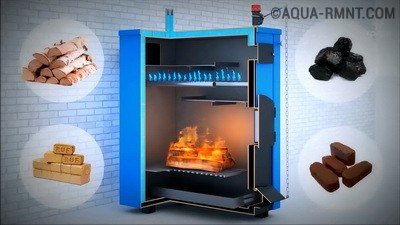
Coal, firewood, pellets, peat, etc. can be used as fuel for solid fuel type boilers.
Stage # 2 - warming up the coolant
The temperature in the furnace continues to rise and reaches values of 1300°C for coal-fired boilers and about 1000C for wood-burning ones. The coolant continues to warm up. At this stage, control is important, otherwise it can warm up to the maximum temperature of the boiler, which leaves 95 ° C, and this is already dangerous.
Regulation is carried out using a valve that controls the air supply. The optimum temperature must be maintained until complete combustion of the fuel. At this phase, the pipes in the room become hot, the air warms up.
Stage # 3 - fuel burnout
At the end of the boiler cycle, the fuel burns out completely, and embers are formed. The temperature drops to 600°C-400°C, which are considered the most comfortable for the system. The coolant slowly cools down, the air in the room also begins to gradually cool down. After glowing coals have formed, the process of cooling the air and coolant immediately accelerates.
Having considered all the phases of the operation of a solid fuel boiler, you can clearly see it main feature– temperature cycling. It is due to the need from time to time to lay a new portion of fuel in order to minimize fluctuations in the temperature of the coolant. To a greater extent, this problem has been solved in automatic boilers, where there is an automated fuel supply and burner fan pressurization. The rest need constant human control and timely replenishment of the fuel supply.
How is a solid fuel boiler arranged?
It must be understood that a solid fuel boiler is a modular structure assembled in a steel case, which includes the following components:
- combustion chamber equipped with a door. This is where the combustion process takes place.
- Grate. Fuel is placed on it and evenly distributed. After it burns out, the resulting ash is poured into the ash pan through special holes.
- Cleaning hatch. Designed to clean the boiler.
- heat exchanger. It is a structure that transfers energy from a heated coolant to a cold one. Most often this is a barrel through which smoke pipes are laid. The gases passing through them heat up the coolant circulating in the heat exchanger.
- thermostat for the boiler, which allows you to adjust the rate of combustion of fuel.
In addition to the above mandatory elements of the device, they can also be equipped with equipment that greatly facilitates their operation. For example, such as draft regulator, gas burners, thermostatic valve. Read on for more details on each of them.

Schematically, the device of a solid fuel boiler is shown in the figure.
draft regulator indispensable when adjusting the temperature inside the supply pipeline and controlling air access to the combustion chamber. The device expands when heated and can act on the damper, opening or, conversely, closing it when the equipment cools. Boilers equipped with such a regulator can operate in automatic mode. The device is installed on the front wall of the equipment. When starting the boiler, it is regulated in such a way that the temperature values do not fall below 65°C and do not rise above 90°C.
Gas-burner runs on natural or liquefied gas and allows you to get many advantages:
- Ignition takes only a few seconds.
- Safety in use.
- Simple design, which ensures the reliability of the equipment.
- Possibility of combination with boilers of different types.
- Operation in enclosed spaces.
thermostatic valve designed for emergency heat removal from the boiler in case of overheating. To cool the apparatus, the hot coolant is drained from the system, and cold water is pumped in instead of its place. The cooling circuit for steel equipment is installed inside the device, and for cast iron - on the supply.

The use of a gas burner allows you to get almost instant ignition and safety in using the device. Such a burner can be installed in boilers of any type.
Types of devices according to the principle of fuel combustion
There are several types of solid fuel boilers. Let's consider them in more detail.
Option #1 - classical combustion boilers
The equipment has a large firebox in which fuel combustion occurs naturally. In the design, as a rule, there is a coolant temperature sensor-controller, with the function of mechanically adjusting the air damper. Such boilers are extremely simple in design, which makes their cost relatively small, and operation is very easy. In addition, they are very unpretentious in terms of the type and quality of fuel and can be heated both with coal and with firewood, briquettes, etc. However, classical devices also have disadvantages:
- Short burn time. As practice shows, one bookmark of fuel can be enough for a maximum of eight hours of operation.
- The complexity of automation of heating modes.
- Lower than other types of solid fuel boilers, efficiency, which leads to high fuel consumption.
- A suboptimal combustion process leads to increased ash content.
Of all these shortcomings, the problem of frequent fuel loading lends itself to leveling. It is partially solved by installing a heat accumulator tank, which accumulates heat and thereby smoothes out the temperature fluctuations of the coolant. The tank is a metal container with good thermal insulation. Its volume is calculated depending on the capacity of the heating system and the power of the equipment. However, its presence is an additional cost and the risk of system failure.

Traditional boilers of classical combustion are very undemanding to fuel. However, due to their design features, their efficiency is lower than that of other devices, so they are characterized by increased ash content and high fuel consumption.
Option # 2 - long-burning devices
These boilers are devoid of the disadvantages described above. There are two types of such devices - pyrolysis and devices of the "smoldering" type. Pyrolysis solid fuel boiler long burning differs from the classical one by the presence of two combustion chambers. Fuel begins to burn in conditions of oxygen deficiency. Under the influence of high temperatures, it begins to emit wood gas, the so-called mixture of carbon monoxide, propane, methane and hydrogen. This process is called pyrolysis. At the end of this process, the fuel enters the second chamber, where it is burned with excess oxygen. As a result, the efficiency of the system increases up to 90%.
The fuel burns almost without residue, the ash has to be removed every few days. One download is enough for an average of 12 hours. Average fuel consumption is low. The advantages of pyrolysis devices include:
- Possibility of maintenance of the set temperature of the heat carrier.
- Work on various types of solid fuels: coal, briquettes, firewood.
- Wide possibilities of automation of combustion mode control systems.
The disadvantages of the system include the higher cost of equipment, energy dependence and exactingness to the level of fuel moisture.
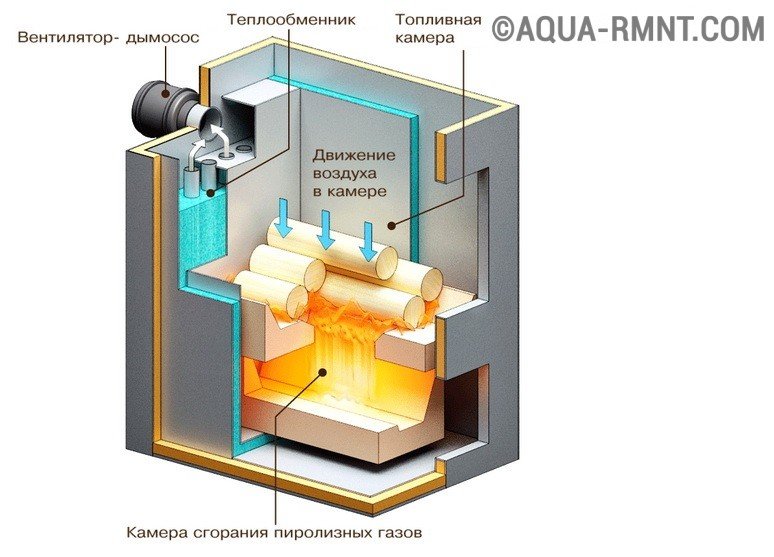
Pyrolysis boilers are distinguished by the presence of two combustion chambers. In the first, pyrolysis occurs, that is, the release of wood gas, and in the second, the actual combustion of the material
Devices of the "smoldering" type are distinguished by the presence of a water jacket built around the entire perimeter. The combustion process is like a candle - from top to bottom. The process of slow smoldering of the upper part of the fuel and the large volume of the combustion chamber, and in some cases it reaches 100 liters, allows you to stretch the combustion process for a long time.

The device of smoldering boilers is such that the fuel, set on fire from above, can burn without adding a new portion for a long time, sometimes up to several days.
There are models that can "hold out" on one coal bed for five days. To this undoubted advantage of the apparatus, one can add a slightly lower cost than that of pyrolysis boilers. However, these devices are very demanding on fuel. It should be either top quality coal or wood with a moisture content of no more than 20%. It is also necessary to pay attention to the resin content in the fuel, if it is high, frequent cleaning of the system is inevitable and the automation fails faster.
Which brands should be preferred?
The most famous manufacturers of solid fuel boilers of the classical type of combustion can be considered:
- S.A.S. The company has more than 30 years of experience in the production of heating equipment. Produces more than nine models of boilers for various purposes.
- Aton. The manufacturer produces three series of devices TTK V, TTK and TRADYCJA. The first two modifications are completely non-volatile, the latter is equipped with automatic control and pressurization.
- Galmet. A large number of variations of different power, designed to work on coal, wood, briquettes, as well as combined models.
- SIME. The company offers two types of devices. The range of the Solida brand includes six boilers with power variations from 16 to 40 kW. The Solida Evolution model range is represented by five devices with a power range of 23-67 kW.
The average cost of such devices depends on the power and starts from 20 thousand rubles.
Among the most famous manufacturers of pyrolysis boilers include:
- ATMOS. Models are produced for working on coal, wood or coal, pellets, combined, with the possibility of installing a gas burner.
- VERNER. The company produces equipment of the VERNER V brand, classic pyrolysis devices designed to work on biomass. Two modifications of VERNER V45 and VERNER V25 differ in power.
The cost of devices starts from 40 thousand rubles.
The most popular manufacturers of devices of the "smoldering" type:
- Stopuva. Models with power from 10 to 40 kW are produced, working on wood or coal and wood.
- Candle. Variations of various power are produced, using firewood, wood chips, peat, briquettes as fuel.
The price of equipment starts from 40 thousand rubles.
Solid fuel boilers– reliable and practical devices. They make it possible to use almost any type of fuel, which is very convenient. The main disadvantage of classical combustion devices is the temperature fluctuations of the coolant. However, long burning modifications do not have it. This equipment can be fully automated, which makes it possible to use the device with maximum convenience.
All types of boilers on the market of modern heating systems can be classified according to the types of fuel used, efficiency, methods and types of installation, price category and a number of other characteristics.
To date, heating systems using gas or electricity have gained the greatest popularity. At the same time, a sufficient number of devices have appeared on the market that can generate heat in innovative ways. These are all kinds of heat pumps, systems based on the conversion of solar energy (solar systems) and air movement energy (wind generators), and so on. Wherein heating boilers, made on the basis of classical technology of use, still do not lose their relevance.
Solid fuel, in which the combustion process is provided by the combustion of wood, coal or peat briquettes, have been used by people for quite a long time. It was solid fuel boilers that were used to convert the energy of steam turbines. Also, this type of boilers was used to heat various types of premises of a small area, in particular residential buildings. Electric and gas analogues began to displace classic boilers from the market. But the lack of oil resources and electricity, as well as their cost, returned the relevance of solid fuel types of boilers for use as heating systems for domestic needs.
A significant disadvantage of solid fuel boilers the need for periodic monitoring of the combustion process and the need to add fuel during operation. But modern boilers operate using mechanisms that significantly increase the duration of work (long-burning boilers). The efficiency of such systems is also increased. This is ensured either by replacing the combustion process with smoldering, or by using surface combustion systems. The efficiency in such cases reaches 95%. Read more on the corresponding page of the site.
The main types of solid fuel boilers:
- Cast iron solid fuel boilers the most common type of boilers using solid fuel. The fuel used is wood and coal, in particular in the form of briquettes. Main advantages: convenience of a cycle of work and full autonomy. The process does not depend on the availability of electricity. At the same time, the use of firewood in this type of boilers is impractical, since the wood burns out quite quickly, on the order of several hours. Therefore, it is worth using coal as the main type of fuel.
- differ in that the most suitable type of fuel for them is hardwood firewood. A typical boiler is equipped with two combustion chambers. The first chamber is designed to create and maintain primary combustion due to the created oxygen deficiency, as a result of which the pyrolysis mechanism is triggered and synthesis gas generation begins. The second chamber is used for afterburning the produced synthesis gas, which significantly increases the time of operation of the boiler on one load of firewood, namely, the combustion time for one load of logs is increased to 6-10 hours, depending on the type of wood. In this case, the efficiency will be about 90%.

- got its name from the type of pellet fuel used. Pellets are compressed wood in the form of cylindrical pellets. The design of the boiler is supplemented with a bunker, which is used for automatic loading of fuel using an auger. The ignition process is automatic and depends solely on the availability of the required amount of fuel in the bunker. Modern technologies make it possible to equip such a boiler with a system for pneumatic fuel supply. This will allow loading pellets quite rarely: it will be enough to fill the bunker with fuel at the beginning of the heating season. Further, the process will be fully automated. The only drawback of such boilers is special fuel. Solid fuel boilers of long burning made it possible to eliminate the main drawback of their class of boilers. One fuel load provides autonomous operation for a period of 12 hours to several days. Both wood (firewood, sawdust, wood chips) and coal or peat can be used as fuel. The duration of the combustion process is ensured by the modernized design of the chamber. The combustion process itself occurs in stages from top to bottom, ensuring fuel smoldering. The amount of fuel for a single load reaches 50 kg, depending on the characteristics of a particular model.
The only drawback of such a model is the price, usually higher than the prices of other types. But the cost-effectiveness of the work quickly compensates for the costs incurred.
Let's summarize.
Modern modifications of solid fuel boilers can compete with gas and electric systems in the market. A closer review of solid fuel boilers allows us to say that, regardless of the model and performance of the boiler, reviews about heating with solid fuel boilers are mostly positive. Although the main problem is still the need to reload fuel. Improved technologies and the complete independence of solid fuel systems from the increasingly expensive and not always available gas and electricity resources make them more and more attractive.
Innovative technologies used in the design of solid fuel boilers, combined with modernized heating systems, have allowed solid fuel boilers to firmly occupy their niche in the market.
The concepts of coziness and comfort in the house are inextricably linked with warmth. Therefore, first of all, modern housing should have a high-quality heating system. Its main component is a heating boiler, which heats the coolant to a predetermined temperature. Such units can be of different types, operating on different fuels and having a different principle of operation from each other. One of the most popular on the market are solid fuel boilers.
How is a solid fuel boiler

To understand how boilers work on solid fuel, you need to know how they are arranged. These structures consist of the following components:
- combustion chamber. It is here that the fuel is loaded, which, when burned, releases the necessary heat. This chamber is equipped with a special door.
- Grate. It is on it that fuel is placed during loading. When it burns out, the ash falls into the ash pan located below.
- Cleaning hatch, which is used to clean the boiler from combustion products.
- heat exchanger, through which the coolant is heated. This component is made in the form of a large container through which fire pipes pass. The gases released during the combustion of the fuel circulate through the pipes of the system, due to which the coolant is heated in the heat exchanger.
- thermostat, which determines the rate of fuel burnout.
Important! The above elements are considered to be the main ones in such constructions. However, in addition to them, such equipment may include additional components, greatly facilitating the operation of the system. These include gas burners, draft regulators, thermostatic valves, etc.
The draft regulator is a very important component through which the temperature inside the supply pipe is regulated. Thanks to him, air is controlled in the combustion chamber. Under heating, this equipment expands, as a result of which it acts on the damper, slightly opening it.
Important! The operation of boilers with a draft regulator can occur automatically, without human control. The regulator is a small device placed on the front wall of the boiler. When the boiler starts up, the regulator ensures that the operating temperature is kept between 65-90 degrees Celsius.

The gas burner can run on LPG or natural gas. Its presence in the system provides several important advantages:
- The ignition process does not exceed a few seconds.
- Simplicity of a design thanks to what the equipment receives necessary reliability.
- High level of security.
- Possibility of use in boilers of various types.
- Operation in enclosed spaces.
Due to the presence of a thermostatic valve, rapid heat removal is ensured in case of overheating of the boiler. In this case, in order to cool the apparatus, the heated coolant is drained from the system, the place of which is filled with cold water.
Important! In devices with a cast-iron case, the cooling circuit is located on the supply, and in steel counterparts - inside the case.
How a solid fuel boiler works

Solid fuel boilers, in addition to wood, can be used in their work different types fuel. These can be pellets, peat, coal, etc. The operation cycle of a classic boiler includes three phases:
- Ignition. The operation of the equipment begins with ignition. On the this stage there is a sharp increase in temperature in the chamber (up to 600 degrees Celsius). The temperature also rises in the furnace exchanger, reaching a value of 40-70 degrees. In this case, a lot is determined by the parameters of the system.
Important! At a minimum, thermal shock may occur, which may have Negative consequences for both the heat exchanger and the system. Cast iron heat exchangers are able to withstand such loads for a long period, but over time they simply burst. With rapid heating against the background of a low speed of liquid circulation, boiling of the liquid is possible, as a result of which the heating system experiences a water hammer. Plastic pipes are the most vulnerable to this phenomenon. On the initial stage equipment operation, the following happens: the air in the room remains cold, but the pipes are already warm enough. Therefore, the correct calculation of all indicators is very important.
- The second stage is characterized by heating the coolant. Rising, the temperature in the furnace reaches a value of 1000-1300 degrees. At this stage, it is very important to control the heating of the coolant, which can heat up to 95 degrees, which is dangerous for the system. You can regulate the degree of heating by means of a special valve that provides air supply to the system.

Advice! It is necessary to control the temperature of the coolant until the fuel burns out completely. This phase is characterized by heating pipes and heating the air in the room.
- At the third stage, the fuel burns out. When the fuel burns out completely at the end of the cycle, embers are formed. Against this background, the temperature in the system also decreases, reaching 400-500 degrees. And it is this temperature regime that is most comfortable for the system. There is a slow cooling of the coolant, during which the air in the room also cools.
Important! When glowing coals are formed, the cooling process of both the coolant and the air in the room is accelerated.
Based on the results of the work cycles discussed above, it can be concluded that solid fuel heating boilers are characterized by one feature - temperature cycling. And in order to minimize the temperature variation, it is necessary to periodically put a new portion of fuel into the system.
The solution to this problem was implemented in automatic boilers. In such designs, fuel supply and burner fan pressurization are carried out automatically. Ordinary design options require constant monitoring.

gas boilers represent the most profitable solution for heating a private house. Such equipment has a fairly large number of characteristics, the main of which is the type of execution. Boilers are floor and wall. And for many people, choosing one of these options is quite a challenge. Therefore, in order to make the right decision, it is necessary to consider the main characteristics and differences between floor and wall units.
The principles of operation used in solid fuel boilers
There are several options for solid fuel boilers. The differences in this case are in the principle of fuel combustion, from which to no small extent depends on the time of work from one load.
Classic models
Such equipment is equipped with a large firebox, where fuel combustion occurs naturally. Such designs involve the use of a special sensor that monitors the temperature of the coolant.
Important! Boilers of the classic type are characterized by a very simple design, which greatly simplifies their operation and reduces the cost. Such units are undemanding to fuel and can run on wood, coal, briquettes and other similar raw materials.
These designs have some disadvantages:
- Low efficiency compared to long-burning boilers.
- Short burning time: no more than eight hours of work on one tab.
- Due to the non-optimal combustion process, an increased ash content appears.
- Heating modes are difficult to automate.
Advice! Of the shortcomings described above, only one can be eliminated. The problem with frequent loading can be partially solved by installing a special tank that can reduce the likelihood of temperature changes due to the accumulation of heat. Such a container is all-metal and should have good thermal insulation performance. The calculation of the volume of such a tank is made depending on the heating system, as well as the power of the equipment.
Long burning designs
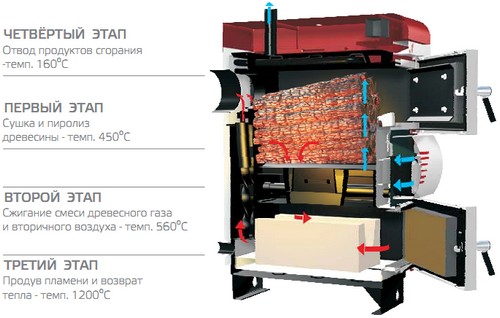
Long-burning units do not have the disadvantages inherent in their conventional counterparts. They are of two types:
- The design of pyrolysis boilers has two combustion chambers. The peculiarity of their work is that the combustion of fuel is carried out in conditions of an insufficient amount of oxygen. The temperature in the chamber rises, causing the release of wood gas. This process is called pyrolysis. Further, the gas penetrates into the second chamber, where it is burned with an excess of oxygen. Thanks to this feature, the system as a result has a very high efficiency, reaching up to 90%.
- Aggregates of the "smoldering" type. Such designs are equipped with a built-in water jacket, which is installed around the perimeter of the unit. In this case, the fuel does not burn from the bottom up, as usual, but from the top down, which, along with a large volume of the combustion chamber (up to 100 liters), ensures a long process of equipment operation.
Video: choose a solid fuel heating boiler
A solid fuel combustion boiler of the pyrolysis type is able to ensure complete combustion of the fuel. Cleaning the system from ash is carried out no more than once every two to three days. With relatively low fuel consumption, such designs are able to operate on a single load for about 12 hours.
Also, the advantages of such units include:
- The ability to maintain the required temperature of the coolant for a long time.
- The system that controls the combustion process can be automated.
- Heating a house with a solid fuel boiler of this type may involve the use of other types of solid fuel along with firewood.
Important! The disadvantages of pyrolysis boilers are the high cost of such equipment and the requirements for the permissible moisture content of the raw materials used. It should also be remembered that such installations are volatile, and therefore may not be used in all situations.
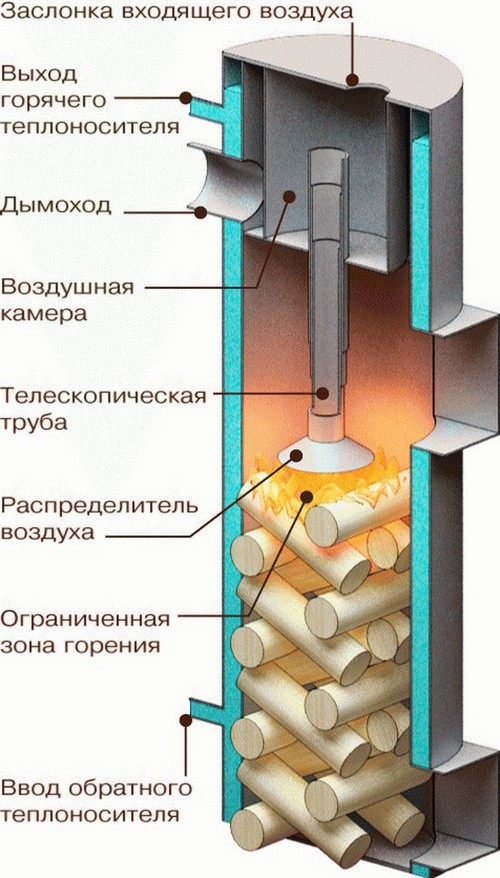
Glow-type models also have their advantages:
- Depending on the model, such designs can work up to 5 days on one tab. Naturally, in this case, the duration of work depends on the type and quality of the fuel. Coal burns the longest.
- In comparison with pyrolysis, such boilers have a lower cost.
Among the shortcomings, it is necessary to highlight the high demands on fuel. Only wood with a moisture content of up to 20% can be used in smoldering boilers. Also, fuel containing a large amount of resins is not allowed to be used. If it is still used, then the system will have to be cleaned much more often, which leads to a decrease in the life of the automation.
The best boiler manufacturers
Today, boilers for heating a private house are produced by a number of companies. To purchase a truly high-quality option, you need to pay attention not only to specifications selected unit, but also on the brand. The most popular are the following manufacturers:
- Buderus. German company specializing in the production of high quality heating equipment. It is one of the leaders in the European market.

Solid fuel boilers Buderus - high quality and efficiency
- Wisman. Italian company founded in 1917. Today, the manufacturer is a true veteran of the heating equipment market, with 22 plants located around the world. Every year, the company introduces new technologies into the production of its products, which allows it to create the highest quality heating units at relatively low prices.
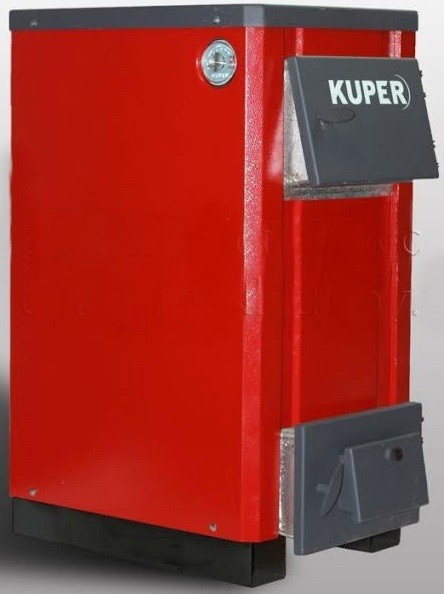
- Lemax. The company producing solid fuel boilers equipped with steel heat exchangers is located in Taganrog. Boilers Russian production proved to be excellent as reliable units. The company's products are different high quality at a competitive cost.
- Don Conord. Another Russian manufacturer whose products have gained considerable popularity in the domestic market. The plant is located in Rostov-on-Don and is engaged in the production of high-quality heating equipment.
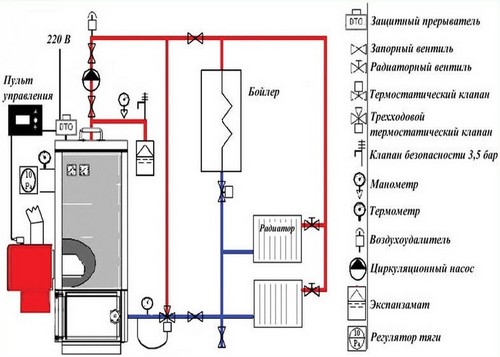
Conclusion
Solid fuel boilers are the most popular heating equipment for private use. They are produced in various designs, on which the technical characteristics of these units directly depend. Therefore, the choice should take into account a number of important nuances described above.
Should I change oil or electric boilers to solid fuel boilers? Will home heating costs go down? What are they - solid fuel heating boilers?
Let's figure it out.
Selecting a heat source
Costs
To begin with, let's find out how cheap solid fuel heating boilers are compared to other sources of thermal energy. Fortunately, information on the cost of a kilowatt-hour of thermal energy received different ways, easy to find.
An important point: information is often presented somewhat biased.
For example, manufacturers of heat pumps willingly provide statistics according to which their heating method is the cheapest.
Of course, on the websites of gas equipment sellers you will find a completely different price breakdown.
Let's take data from an independent source.
They may not accurately reflect the current situation in individual regions; however, the approximate ratio will remain.
- A kilowatt-hour of heat obtained by burning main natural gas will cost about 0.52 rubles.
- for the production of a kilowatt-hour of heat, exactly one kilowatt-hour of electricity will be spent, which on average in Russia now costs about 3 rubles. When using a heat pump of any type instead of direct heating, the price of heat will decrease by about 3-3.5 times.
- During the combustion of diesel fuel, a kilowatt-hour of heat released will cost about 2.8 rubles.
- A solid fuel heating boiler when burning wood will provide us with costs at the level of 0.8 r / kWh.
- A coal-fired solid fuel heating boiler will increase costs up to 1.2 r / kWh.

The conclusions are obvious.
- Gas is the cheapest. If your home has a gas main, the choice is obvious.
- The second place is shared by solid fuel heating boilers for wood and.
- On the third - a solid fuel heating boiler that runs on coal.
The convenience of use
Cheap heating equipment evaluation begins but does not end. Another important factor is ease of use.
By what criteria can this parameter be evaluated?
- The ability to work in a completely autonomous mode for a long time.
- The ability to maintain the set temperature in the room with high accuracy. We emphasize: it is indoors. The climate in the house is non-linearly related to the temperature of the coolant: the weather outside affects it at least as much.
Any heat pump, regardless of the source of low-grade heat, is a fully automatic system and, as a rule, equipped with electronic thermostats already in the factory.
Gas boilers, as you know, are divided into non-volatile and equipped with electronic ignition. In the former, a simple mechanical thermostat is implemented; the latter are capable of using remote sensors in any part of a heated house. Neither of them require frequent maintenance.
What, in terms of convenience, can solid fuel heating boilers offer us?
- Protection of a solid fuel boiler against overheating of the coolant is, as a rule, the same simplest mechanical thermostat, which, when the critical temperature is reached, closes the blower by means of a lever and a rod.
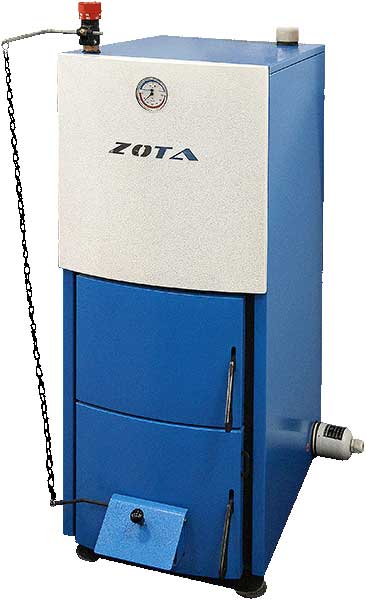
- Remote temperature sensors can only be used by gas-generating boilers, which require forced air to maintain two-stage fuel combustion. The fan speed in this case is regulated by simple electronics.
- Finally, autonomy. With her ... let's say delicately - everything is bad.
Do-it-yourself simple low-power devices burn a supply of firewood in 1-3 hours; the absolute record holder in terms of burning time is the Lithuanian solid fuel boiler Stropuva, which, thanks to an unusual fuel combustion scheme, is able to work on one tab for up to one and a half days.
We will analyze the principle of operation of upper combustion boilers of Stropuva and other manufacturers in the corresponding section of the article.
However, as usual, the devil is in the details.
- Main natural gas is not available everywhere, and the use of bottled propane practically equalizes the cost of heating with an electric boiler.
- An air source heat pump only works effectively at winter temperatures around zero degrees Celsius. With a decrease in street temperature, the consumption of electricity for the production of a kilowatt of heat increases; at -25 and below, air source heat pumps simply do not work.
- operating according to the “water-water” scheme are more versatile, but in terms of purchase and installation costs they are comparable to the costs of building a small house. For comparison: the Russian steel boilers Karakan and Dobrokhot with a capacity of 12 kW cost about 14-16 thousand rubles, and the Ukrainian 14-kilowatt Cleaver can be bought for 2,500 hryvnia (10,000 rubles at the current exchange rate).
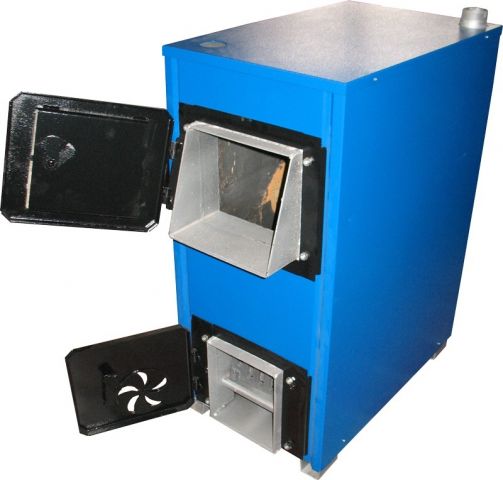
That is why in practice, where the gas pipeline is located at a considerable distance from the construction site, it is solid fuel heating installations that are leading in popularity.
Boiler types
Let's try to figure out how devices can be classified.
Material
- Steel is durable and allows you to make the walls of the boiler and heat exchanger relatively thin, and, therefore, cheap. However, the downside of low cost is limited durability. It is from steel that a huge number of home-made structures are made. Instructions and drawings, if desired, are online in minutes.
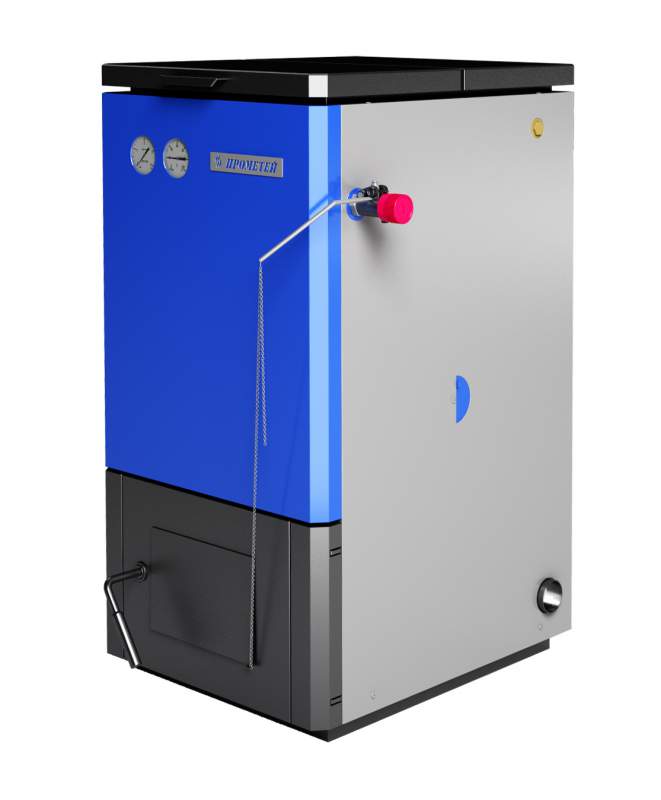
Useful: the service life of a steel firebox is significantly increased if it is lined with refractory bricks.
- Cast iron is more typical for massive devices with a power of 20 kW or more.. Low mechanical strength (primarily in relation to shock loads) makes the walls of the boiler and the firebox thick enough; as a result, the weight of the boiler can reach 250-300 kilograms.
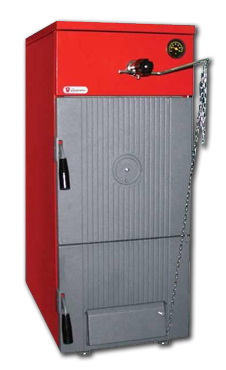
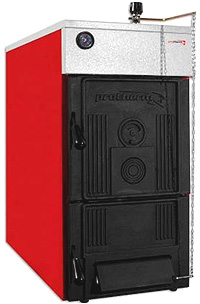
Type of fuel
- Wood boilers are able to work only and exclusively on wood with a moisture content of not more than 20%.
- Coal, respectively, are optimized for more high temperature combustion of coal.
- Pellet are designed for the use of woodworking waste pressed into granules. The advantage of devices of this type is in the automated supply of fuel from the bunker, which makes it possible to make the loading quite rare; however, in practice, it is far from possible to ensure an uninterrupted supply of pellets far from everywhere, and their cost is incomparable with coal or firewood.
- Universal products can use different types of fuel. A variety of combinations of thermal energy sources are possible: for example, a solar burner can be mounted in a separate firebox of a wood-burning boiler; a coal-fired boiler can be supplemented with several heating elements in a heat exchanger tank, and so on.
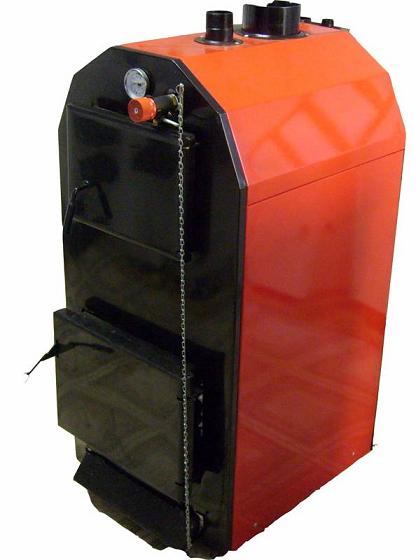
Yaik KSTGZH-16A after installing the burner in the firebox is able to switch from wood to gas or diesel fuel.
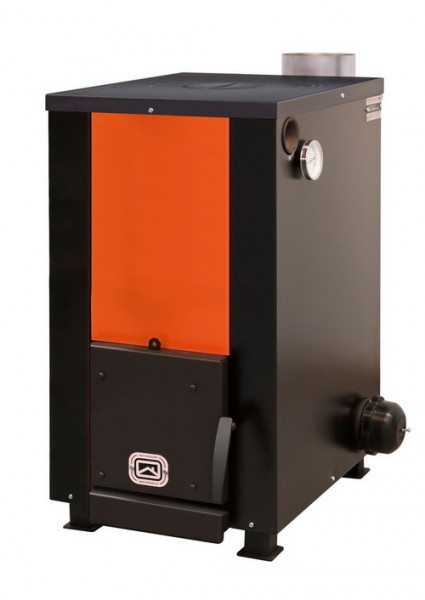
Traction type
- Natural draft comes from the difference in density between the hot combustion products and the surrounding air. The advantage of the scheme is non-volatile; the disadvantage has already been mentioned: only the most primitive control of the temperature of the coolant is possible.
An important point: the restriction of air flow through the blower means, among other things, a drop in efficiency due to incomplete combustion of the fuel.
- Forced draft allows you to flexibly adjust the thermal power of the device using programmers and remote thermostats; however, in the absence of electricity, the boiler will be shut off automatically.
Given the specifics of the Russian outback, where wire breaks and thefts are not uncommon, it is not easy to make an unambiguous choice in favor of such a solution.
Non-standard solutions
There are several designs that deserve special mention.
Pyrolysis (gas generating) boilers are distinguished by the fact that in them the combustion of fuel is divided into two phases. During the combustion of wood with limited access to oxygen, the so-called pyrolysis gas is formed, which is then burned in a separate chamber.
What is the result?
- The efficiency increases. For the best boilers of this type, it reaches 92%; in addition, the efficiency does not drop when the thermal power is limited.
- There is a minimum of solid waste.
- The regulation of the combustion process is made more flexible.
- Firewood is required every 10-12 hours.
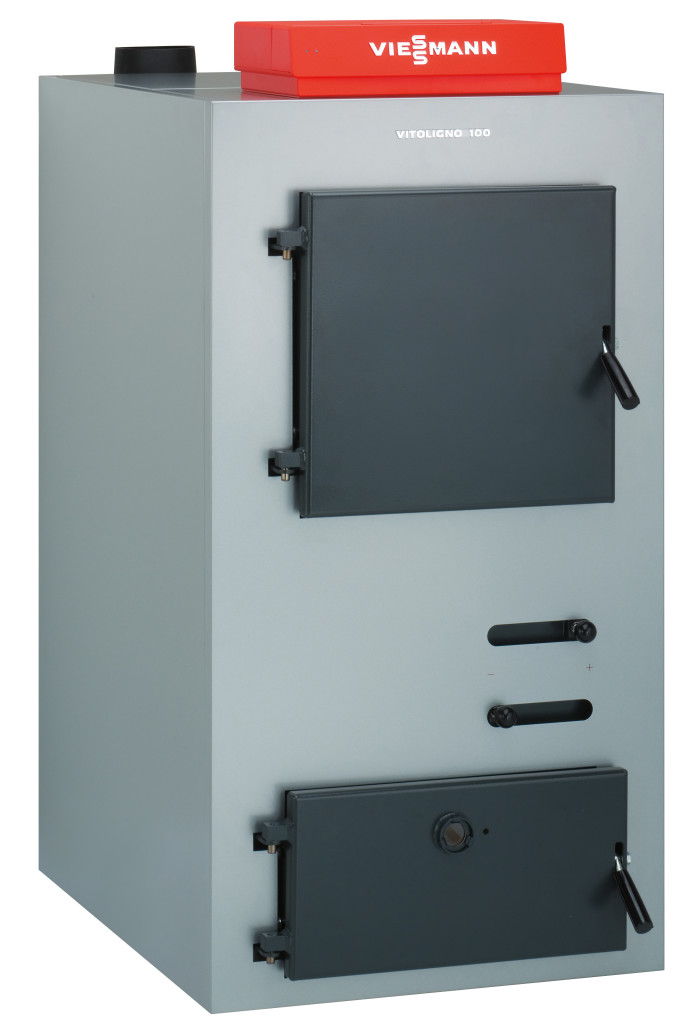
Upper combustion boilers require loading and does once every 20-30 hours. Combustion occurs only in the upper layer; firewood, coal or peat smolder with the release of pyrolysis gas, which burns out in the same furnace, but behind a massive metal separating disk. The ash is carried away by the ascending air current.
![]()
Heating and cooking boilers are equipped, in addition to the built-in heat exchanger, with a cooking surface above the furnace.
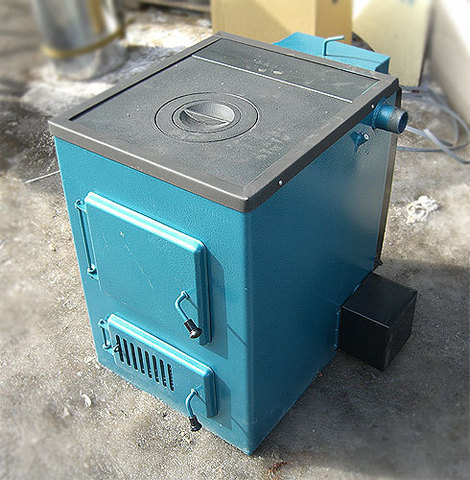
In the photo - heating and cooking Smoke AOTV-18.
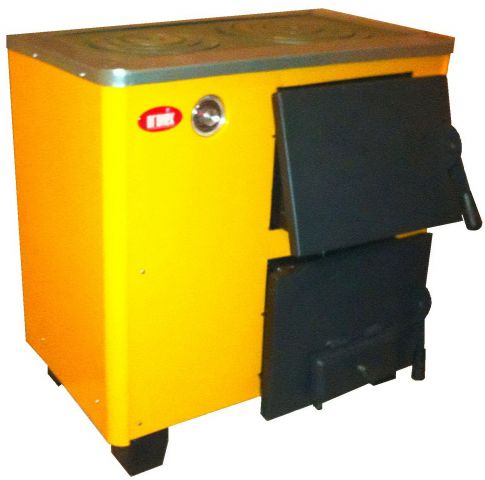
Conclusion
Modern solid fuel heating boilers are a worthy and, most importantly, inexpensive alternative to electric and liquid fuel heating installations. As usual, in the presented video in this article you will find additional information on this topic. Warm winters!
Conventional solid fuel boilers have one drawback. They require increased attention. It is necessary to put fuel in time, clean it, etc. These inconveniences can be overcome by solid fuel boilers of long burning, designed for a long cycle of work. What provides this convenience?
Installation of uninterrupted supply of bulk fuel
The principle is very simple. A bunker is connected to the boiler, into which, as a rule, wood pallets are loaded. Screw feed sends them to the furnace, where they burn. The convenience lies in the fact that, thanks to the impressive capacity of the bunker and automatic fuel supply, you can forget about the boiler for a while and calmly go about your business.
The Czech company Viadrus produces a range of solid fuel boilers equipped with bunkers.
Ekoret. It can work on wood pellets, brown and hard coal. Power, depending on the configuration, is achieved from 4.5 to 25 kW. The combustion chamber is made of steel, protected by ceramic plates. Cast iron heat exchanger. Fuel supply, pump and fan operation are controlled by automation connected to a temperature sensor. In case of overheating, protection is provided by a safety thermostat.
Hercules ECO. Solid fuel boilers of long burning of this model range have a capacity of 7 to 42 kW. They work on wood pellets. A distinctive feature is automatic ignition, the ability to work with solar systems, equithermal regulation of boiler and heating water. Exhaust gases contain minimal amount emitted harmful substances, due to which this series received the Ecological economical product mark. Fuel is transported through a flexible hose thanks to a screw feed. The boilers are equipped with a safety thermostat.
These long-burning solid fuel boilers can be equipped with bunkers of various sizes, which can be connected to the unit both on the left and on the right.
Pyrolysis boilers
Solid fuel boiler Buderus Logano S121-2 German production. Made of steel, depending on the configuration, it can provide power from 18 to 38 kW. It can perform both a solo part and perform in a duet with a gas or liquid fuel boiler. Perfectly copes with work in gravitational and pumping system.
Convenient control panel, which has, among other things, automatic control of the fan control, depending on the temperature of the gases at the outlet.
A handy thing is the fan switch, which reacts to the opening of the door. Forced smoke gadfly prevents him from getting into the room when loading fuel. The fireclay brick protects the ash chamber from burning out. You can use logs up to 58 cm long. The fire chamber is easily cleared of products of burning.
solid fuel boiler Viadrus HEFAISTOS P1-5. Power is achieved up to 25 - 50 kW. It works on wood, which is burned at a rate of 7 to 14 kg / h. The device withstands water pressure up to 4 bar. The average water temperature is recommended within 60 - 90C.
The fan requires a reliable source of electricity to operate. If there are power outages, then you should purchase an uninterruptible power supply system. The boiler operates at 230 and 50 Hz.
The temperature is controlled by fans and pumps. Automation is connected to a thermometer. It is possible to connect a programmer and a room thermostat. Combustion occurs with minimal residue. The boiler is cleaned 1-2 times (depending on the intensity of work) per week.
For an autonomous heating system in areas with insufficient power supply, long-burning solid fuel boilers equipped with bunkers for bulk fuel are quite suitable. In the same place, where there are no problems with the supply of electricity, a solid fuel heating boiler on the pyrolysis principle is more profitable.








